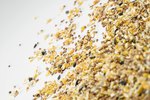
The family Cardinalidae contains 11 genera and 42 species, which are commonly divided into cardinals, tanagers, grosbeaks and buntings. Their habitats range from North to South America. Some are migratory and others are not. Cardinals eat a varied diet of seeds, plants, berries and invertebrates -- the proportion of each varies between species.
Nonmigratory Cardinals
Migratory cardinals are more likely to eat different foods at different times of year, based on their location. Nonmigratory cardinals, like the northern cardinal (Cardinalis cardinalis), are limited to the food sources at their year-round location. Northern cardinals are typically fruit and seed eaters, but about 30 percent of their diet is made up of insects. They eat beetles, crickets, katydids, leafhoppers, cicadas, flies, centipedes, spiders and butterflies when these creatures are active. Cardinals are considered helpful to farmers because they also eat codling moths, cotton cutworms, scale insects, cotton bollworms, grasshoppers, aphids, snails and slugs, all of which are considered pest bugs. Cardinalis sinuatus, or pyrrhuloxia, is another crested, nonmigratory cardinal that eats insects such as grasshoppers, caterpillars, beetles, stinkbugs and cicadas.
Bug Hunters
Depending on the species, cardinals will eat primarily either invertebrates or plants, seeds and fruit. Many of the tanagers (genus Piranga) rely mostly on insects and other bugs for sustenance. The scarlet tanager (Piranga olivacea) eats a wide variety of invertebrates, including ants, sawflies, moths, butterflies, beetles, flies, cicadas, leafhoppers, spittlebugs, treehoppers, plant lice, scale insects, termites, grasshoppers, locusts, dragonflies, dobsonflies, snails, earthworms and spiders. The indigo bunting (Passerina cyanea) eats lots of invertebrates during the summer migration, such as spiders, caterpillars, grasshoppers, aphids, cicadas, canker worms, click beetles and weevils. These plucky little birds can even eat the brown-tail moth caterpillar, whose nasty fuzz can cause serious allergic reactions in people.
Occasional Insect Eaters
Some cardinals only eat large amounts of invertebrates during spring, the breeding season. The rose-breasted grosbeak (Pheucticus ludovicianus) is a migratory cardinal that lives in Canada, migrates through the United States and winters in Central and South America. When migrating, these birds live primarily on berries. During the breeding season they eat mostly insects like beetles, bees, ants, sawflies, bugs, butterflies and moths. The painted bunting (Passerina ciris) eats seeds and berries most of the year, but during mating season bulks up on protein-rich bugs like grasshoppers, weevils, other beetles, caterpillars, spiders, snails, wasps and flies.
Hunting Styles
Different cardinal types will look for food in different ways. Piranga olivacea, or the scarlet tanager, does most of its hunting in high branches and on tree trunks, rarely descending to the ground to look for food. Scarlet tanagers can hunt while hovering or in flight. These birds snuff larger prey by smashing it against a branch or tree trunk. Grubs and larvae they gobble down whole. Rose-breasted grosbeaks pick their food from dense foliage and branches and also snatch insects from the air mid-flight. Painted buntings are ground foragers, but in the breeding season they also search for food in marshes and trees up to 30 feet off the ground. Painted buntings have even been observed plucking bugs from or diving straight through webs to steal a spider's dinner. Northern cardinals forage on the ground and around shrubberies, but are willing to eat from hanging bird feeders.
References
- Encyclopaedia Britannica: Cardinal
- The Cornell Lab of Ornithology -- All About Birds: Northern Cardinal
- BirdChannel.com: Cardinal Birds & Bird Nests
- The Internet Bird Collection: Cardinals (Cardinalidae)
- Creagrus at Monterey Bay: Cardinals, Grosbeaks & Allies
- The Cornell Lab of Ornithology -- All About Birds: Cardinals, Grosbeaks, and Allies
- Animal Diversity Web: Cardinalis sinuatus
Resources
- Artfullbirds: Saltators, Cardinals, and Allies Cardinalidae
- USDA Forest Service: Forest Disturbance Processes -- Development of the Euproctis chrysorrhoea Baculovirus as a Microbial Control for the Browntail Moth
- Animal Diversity Web: Cardinalidae: Pictures
- The Cornell Lab of Ornithology -- All About Birds: Dickcissel
Photo Credits
-
Jupiterimages/Photos.com/Getty Images
Writer Bio
Madeline Masters works as a dog walker and professional writer. In the past she has worked as a fitness columnist, fundraising copywriter and news reporter. Masters won two Pennsylvania Newspaper Association Awards in 2009. She graduated from Elizabethtown College with a Bachelor of Arts in English.


